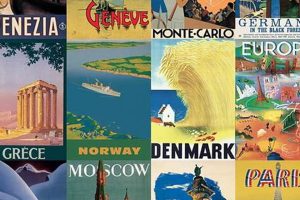The term identifies a category of collectible graphic art originating from Italy. These artifacts, typically printed on paper, served as promotional material for a wide range of products, events, and destinations. Examples include advertisements for Campari, promotions for the Italian Grand Prix, and travel advertisements for the Amalfi Coast.
Such items hold significant cultural and historical value, offering insight into the nation’s artistic trends, economic development, and social attitudes during specific periods. They serve as tangible records of past eras, reflecting prevalent design aesthetics and marketing strategies. The increasing interest in preserving and exhibiting these artifacts has contributed to their recognition as important cultural assets.
The following analysis will explore the stylistic evolution, notable artists, and market trends associated with this specific area of graphic design, further elucidating their enduring appeal and historical significance.
Acquiring Historic Italian Promotional Art
The acquisition of historic Italian promotional art requires diligent research and informed decision-making to ensure authenticity and value retention.
Tip 1: Verify Provenance. Establish a clear ownership history. Documentation such as auction records, gallery certificates, or previous owner statements strengthens the item’s credibility and value.
Tip 2: Assess Condition Meticulously. Examine the paper for damage, including tears, creases, fading, or foxing. Professional restoration can improve aesthetics but may impact value if excessively altered.
Tip 3: Identify Printing Technique. Understanding the printing method lithography, offset, or screen printing assists in verifying the item’s age and authenticity. Examine the print quality and dot patterns for clues.
Tip 4: Research the Artist and Publisher. Familiarity with prominent Italian graphic artists and publishing houses of the period helps differentiate genuine works from reproductions. Look for signatures or publisher marks.
Tip 5: Compare Prices Across Reputable Sources. Consult auction archives, dealer listings, and price guides to determine a fair market value. Be wary of items significantly below market average, as they may be suspect.
Tip 6: Consider Conservation Needs. Plan for proper storage and display to prevent deterioration. UV-resistant framing and acid-free backing are crucial for long-term preservation.
Tip 7: Seek Expert Authentication. When acquiring high-value items, consider obtaining a professional authentication from a recognized expert specializing in Italian graphic arts. This provides assurance and supports future resale.
Careful consideration of these factors contributes to a successful acquisition, ensuring the preservation of these important cultural artifacts and securing a valuable investment.
The subsequent sections will delve into specific artist styles and historical contexts related to this unique area of collecting.
1. Artist's Notoriety
The reputation and recognition of the artist responsible for a vintage Italian poster significantly impacts its valuation and desirability within the collector’s market. A direct correlation exists: posters created by well-known artists generally command higher prices and are more sought after than those by lesser-known or anonymous designers. This is because a recognized name provides assurance of artistic quality, historical relevance, and potential investment value.
Consider, for example, posters created by Leonetto Cappiello. His innovative use of bold colors and simplified forms revolutionized advertising art in the early 20th century. His posters for brands like Campari are highly prized due to his established artistic legacy and the impact his work had on the development of modern graphic design. Conversely, posters of similar subject matter but created by artists with minimal or no recognition are typically valued significantly lower, irrespective of their aesthetic appeal or rarity.
Therefore, understanding the historical context and artistic contributions of the designer is paramount when assessing the value of vintage Italian advertising art. Authentication and attribution are crucial steps in the acquisition process, as the artist’s notoriety fundamentally shapes the poster’s commercial and cultural significance. While aesthetic appeal and subject matter certainly play a role, the artist’s name often serves as the primary driver of market demand and, consequently, price.
2. Subject matter
The subject matter depicted on a vintage Italian poster is a critical determinant of its desirability and value. It represents the immediate visual content, encompassing everything from advertised products and travel destinations to cultural events and political ideologies. This element directly influences a poster’s appeal to specific collectors and reflects the historical context of its creation. For instance, a poster promoting the Mille Miglia race will attract automobile enthusiasts and collectors interested in Italian motorsport history. Conversely, advertisements for now-obsolete products may appeal primarily to those researching social or economic trends of a particular era.
The choice of subject also interacts with the prevailing artistic styles of the time. Art Deco designs often promoted luxury goods or glamorous travel destinations, while Futurist posters might depict scenes of industrial progress or nationalistic fervor. Therefore, analyzing the subject matter in conjunction with the artistic style allows for a deeper understanding of the poster’s historical significance and its intended audience. Furthermore, certain themes are consistently more popular among collectors. Travel posters showcasing iconic Italian landmarks, such as the Colosseum or the canals of Venice, tend to command higher prices due to their broad appeal and representation of Italian cultural heritage.
In summary, the subject matter of a vintage Italian poster serves as a direct link to its historical and cultural context, significantly influencing its collectibility and market value. Understanding the interplay between the subject, artistic style, and historical period is essential for informed collecting and appreciation. The relative rarity of a particular subject matter, combined with its intrinsic appeal, ultimately contributes to its overall significance within the realm of Italian graphic art.
3. Printing technique
The printing technique employed in the creation of these items is a fundamental aspect influencing their aesthetic qualities, historical significance, and ultimately, their market value. Understanding the nuances of each method provides crucial insights into the authenticity, age, and artistic intent of these artifacts.
- Lithography’s Dominance
Lithography was the predominant printing method for vintage Italian posters, particularly from the late 19th century through the mid-20th century. This technique, involving the transfer of an image from a stone or metal plate to paper, allowed for vibrant colors and intricate detail, characteristic of many iconic Italian advertisements. The presence of a visible dot pattern, albeit fine, often indicates a lithographic origin. Examples include early Campari advertisements, which showcase the rich tonal range achievable through multi-stone lithography.
- Offset Lithography’s Introduction
As the 20th century progressed, offset lithography gradually replaced traditional lithography due to its increased efficiency and cost-effectiveness. Offset printing involves transferring the image from a plate to a rubber blanket, and then to the paper. This process often results in a slightly softer image compared to direct lithography. The shift towards offset printing can be observed in posters from the post-World War II era, reflecting the changing economic landscape and printing technology.
- The Role of Typography
Regardless of the primary printing method, the typography employed in vintage Italian posters was often meticulously crafted. Hand-drawn lettering and carefully selected typefaces contributed significantly to the overall aesthetic. Examination of the typographic elements can provide clues about the poster’s period and stylistic influences. The use of distinct typefaces, such as those associated with Futurism, can help identify the poster’s artistic movement and its intended message.
- Identifying Reproductions
A thorough understanding of printing techniques is essential for distinguishing original vintage examples from later reproductions. Modern digital printing methods often lack the subtle nuances and textural qualities of older techniques. Close examination of the ink, paper, and printing process can reveal inconsistencies that indicate a reproduction. The absence of a discernible dot pattern, or the presence of overly sharp and uniform colors, may suggest a modern printing process.
The printing technique represents a critical aspect of assessing these items. From the color brilliance achieved through meticulous lithographic processes to the stylistic choices evident in the typography, each detail contributes to the overall story and value of these historical artifacts.
4. Condition
The physical state of vintage Italian promotional art directly and substantially influences its market value and historical significance. Deterioration diminishes aesthetic appeal, obscures original design intent, and compromises the artifact’s long-term preservation. This necessitates a comprehensive assessment of any prospective acquisition. The presence of tears, creases, fading due to light exposure, or staining significantly reduces an item’s worth. Damage impacts readability and the visual impact, factors central to the poster’s original purpose and artistic merit. A Campari advertisement with significant water damage, for example, is less desirable than a comparable example in pristine condition.
Conservation and restoration efforts attempt to mitigate the effects of aging and environmental factors. While professional restoration can improve appearance, it can also alter the original material and potentially decrease value if overzealously applied. Ethical considerations dictate that restoration should aim to stabilize and preserve rather than entirely recreate. The presence of linen backing, a common conservation technique, can stabilize fragile paper but may also conceal underlying damage. Therefore, a detailed examination of the condition report and awareness of restoration history are imperative. A poster for a vintage Mille Miglia race, though historically significant, may command a lower price if extensive restoration is evident.
In summary, condition represents a primary factor determining the value and longevity of these artifacts. A meticulous evaluation of the physical state, coupled with an understanding of appropriate conservation methods, is crucial for both collectors and institutions dedicated to preserving Italian cultural heritage. The long-term preservation of these valuable resources hinges upon proactive management and the application of best practices to safeguard against further degradation.
5. Rarity
The scarcity of original examples constitutes a central factor in determining the value and collectibility of Italian vintage posters. Limited production runs, wartime paper shortages, and subsequent loss or destruction contribute to the rarity of specific designs, elevating their desirability among collectors and institutions.
- Limited Print Runs & Promotional Campaigns
Many vintage Italian advertisements were produced in relatively small quantities, intended only for short-term promotional campaigns. Once the campaign concluded, excess stock was often discarded. Consequently, surviving copies are exceedingly rare. Specific designs created for limited-edition product releases or regional events are particularly scarce, making them highly sought after by collectors seeking unique and historically significant pieces.
- Impact of War and Conflict
World War II and other periods of social and political upheaval in Italy led to paper shortages and the destruction of existing archives. Many posters were lost or damaged during these periods, further diminishing the available supply. Advertisements produced during these tumultuous times, therefore, often possess a higher degree of rarity due to the circumstances of their creation and survival.
- Artist Specific Scarcity
Posters designed by artists who produced a limited body of work, or whose artwork was predominantly focused on other media, tend to be rarer. Additionally, certain artists may have experienced periods where their commercial work was less prolific. Posters from these periods become especially prized due to their relative unavailability. Collectors actively seek out these less common designs to complete comprehensive artist collections.
- Subject Matter & Historical Context
The subject matter depicted can significantly impact rarity. Posters promoting events or products tied to specific historical moments, or those reflecting unique cultural trends, may be less common due to their limited timeframe of relevance. Examples include advertisements for short-lived political campaigns or promotions for niche products that quickly faded from popularity. The historical context surrounding these items contributes to their rarity and appeal to collectors interested in specific aspects of Italian history and culture.
The interplay of limited production, historical events, and artist-specific output culminates in the relative scarcity of certain vintage Italian posters. This rarity, combined with factors such as artistic merit and condition, determines their desirability and value within the collector market. The quest to locate these scarce artifacts drives the passion of collectors and underscores the historical significance of Italian graphic design.
6. Designer Style
The distinct visual language employed in Italian vintage advertising represents a significant factor in their aesthetic appeal, historical context, and commercial valuation. The stylistic choices of the designer, reflecting prevailing artistic movements and cultural trends, substantially impact the desirability and collectibility of these artifacts. Understanding these styles provides critical insight into the evolution of Italian graphic design and its relationship to broader cultural narratives.
- Art Nouveau & Liberty Style
Predominant in the late 19th and early 20th centuries, this style, known as Stile Liberty in Italy, featured flowing lines, floral motifs, and organic forms. Its influence is evident in posters promoting early tourism and cultural events, characterized by elegant typography and a celebration of natural beauty. Examples include early Campari advertisements, displaying the characteristic curvilinear elements of the period.
- Art Deco
Emerging in the 1920s and 1930s, Art Deco emphasized geometric shapes, streamlined forms, and luxurious materials. This style often portrayed scenes of modern life, technological progress, and glamorous travel. Italian Art Deco posters, for instance, frequently promoted luxury goods and destinations, reflecting the aspirations of a burgeoning middle class. The use of bold colors and stylized imagery characterized this period.
- Futurism
This Italian avant-garde movement, prominent in the early 20th century, celebrated speed, technology, and dynamism. Futurist posters often incorporated fragmented typography, bold geometric shapes, and dynamic compositions to convey a sense of motion and energy. They represent a radical departure from traditional aesthetics, reflecting the movement’s embrace of modernity and its rejection of the past.
- Mid-Century Modern
Characterized by clean lines, minimalist forms, and a focus on functionality, this style gained prominence in the post-World War II era. Mid-Century Modern Italian posters often employed bold colors, simple geometric shapes, and sans-serif typography. They reflected a shift towards optimism and consumerism, promoting a new era of economic growth and technological innovation.
The evolution of designer styles throughout the history of Italian advertising directly informs the visual character and cultural resonance of these pieces. From the organic forms of Art Nouveau to the streamlined aesthetics of Mid-Century Modern, each style reflects the prevailing artistic trends and societal values of its time. The discerning collector recognizes these stylistic nuances, contributing to a deeper appreciation of the historical and artistic significance embedded within these iconic artifacts.
Frequently Asked Questions
The following addresses commonly encountered inquiries regarding authenticating, valuing, and preserving historical Italian advertising art.
Question 1: How can authenticity be verified for Italian vintage posters?
Authenticity verification requires a multi-faceted approach. Scrutinize the printing technique; original lithographs possess a distinct dot pattern. Analyze the paper stock; older papers exhibit unique characteristics. Compare the design to known works by the attributed artist. Consult reputable auction records and expert opinions for confirmation.
Question 2: What factors primarily influence the valuation?
Valuation is determined by the artist’s prominence, the subject matter’s appeal, the printing technique’s rarity, the poster’s condition, and overall scarcity. Provenance documentation further enhances value.
Question 3: How should be preserved to prevent deterioration?
Preservation necessitates UV-resistant framing, acid-free backing materials, and climate-controlled storage to minimize light exposure, humidity fluctuations, and acidic degradation. Avoid direct sunlight and handling with bare hands.
Question 4: What are the common types of damage and how do they affect value?
Common damage includes tears, creases, fading, staining, and foxing. Such imperfections diminish aesthetic appeal and reduce value proportionally to the severity of the damage. Professional restoration can mitigate some damage, but excessive restoration can negatively impact value.
Question 5: Where are reliable sources for acquiring authentic Italian vintage posters?
Acquisition should be limited to reputable auction houses specializing in posters, established art galleries with expertise in vintage graphics, and knowledgeable dealers with verifiable track records. Due diligence and thorough research are essential.
Question 6: What resources are available for researching Italian graphic artists and printing techniques?
Research resources include museum archives, university libraries, specialized art publications, and online databases dedicated to graphic design history. Consultation with experts in the field is also recommended.
Careful consideration of these elements contributes to a comprehensive understanding and informed management of historic Italian promotional art.
The subsequent discussion will outline strategies for curating a meaningful collection of this historic graphic art.
Conclusion
The preceding analysis has explored diverse facets of Italian vintage posters, encompassing their artistic styles, historical context, and critical factors influencing valuation and preservation. From the impact of renowned artists to the significance of printing techniques and the implications of condition, a comprehensive understanding of these elements is essential for collectors, historians, and institutions alike. The inherent value of these artifacts extends beyond mere aesthetics, serving as tangible reflections of Italy’s cultural and economic evolution.
Ongoing research and diligent stewardship are imperative to ensure the longevity and accessibility of these important cultural assets. Further investigation into overlooked artists, unexplored thematic categories, and innovative conservation methods will continue to enrich our understanding and appreciation of Italian graphic design heritage. The preservation of “vintage posters italian” benefits current and future generations by safeguarding invaluable historical insights and artistic legacies.







